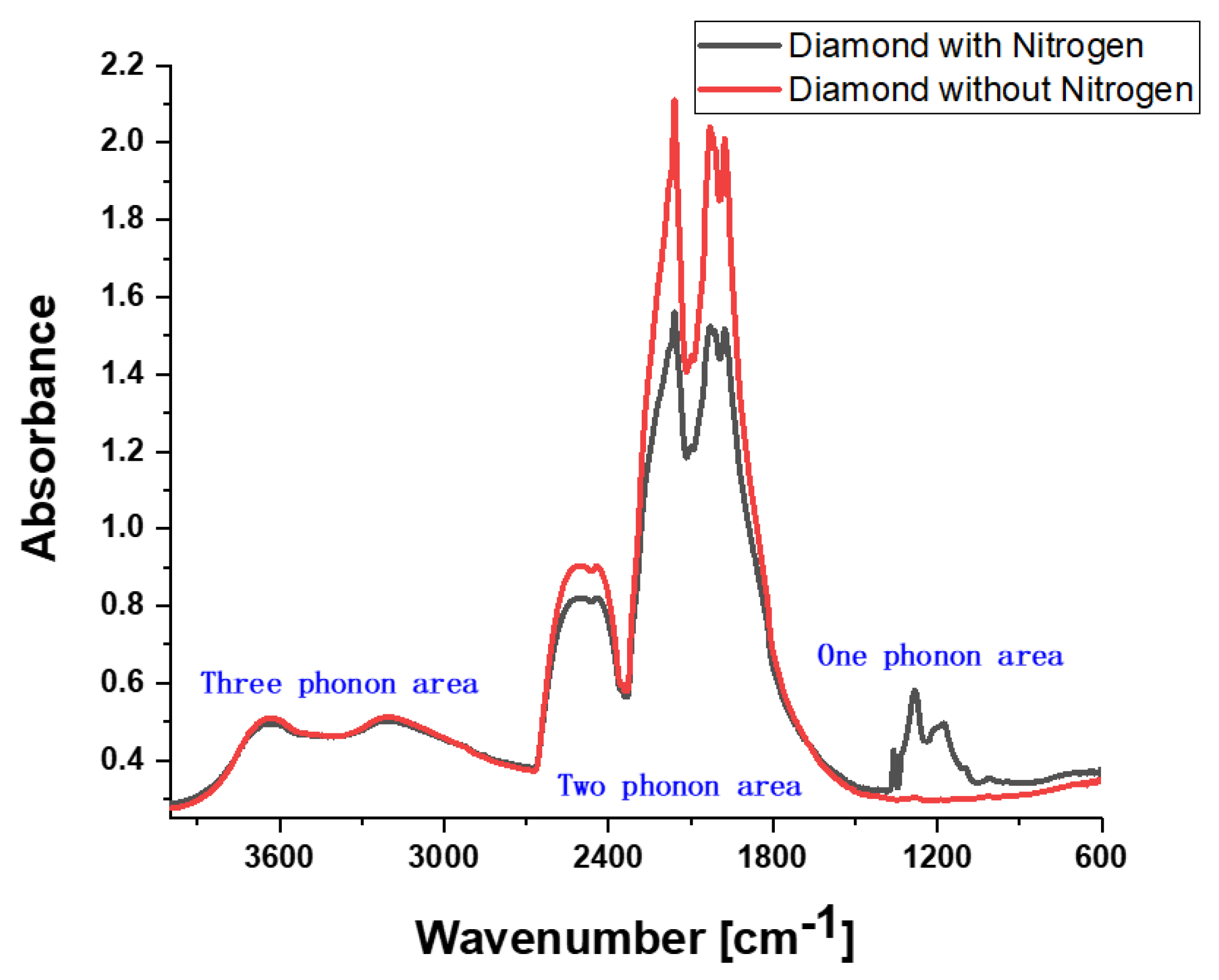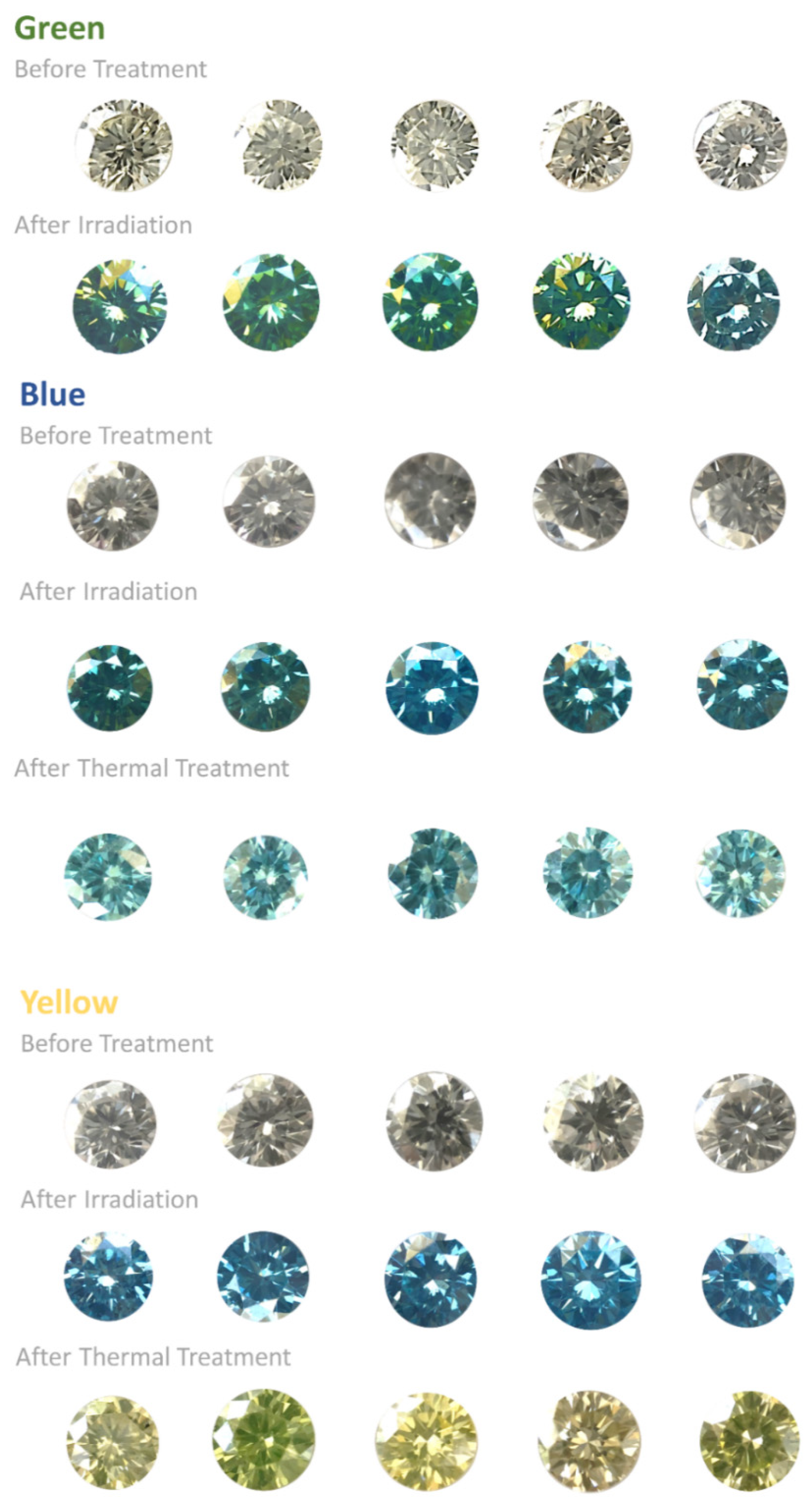Nitrogen Structure Determination in Treated Fancy Diamonds via EPR Spectroscopy
Abstract
:1. Introduction
- (1)
- It is possible to use EPR spectroscopy to determine the nitrogen atom structure in the diamond lattice surrounding the carbon-centered radicals.
- (2)
- The nitrogen distribution in the diamond crystal is homogeneous.
2. Methods
3. Results and Discussion
3.1. Visual Assessment
3.2. Fluorescence under 365 UV Light Excitation
3.3. UV-Visible Spectra of the Diamonds
3.4. FTIR Spectra
3.5. EPR and MATLAB EasySpin Simulations
3.6. Blue Evaluation of the Changes Observed (Figure 6)
4. Conclusions
- (1)
- The optical color centers of green, blue, and yellow diamonds consist of blue optical centers (such as GR1) and yellow optical centers (such as N3 and H3), and the green color is a combination of blue and yellow color centers.
- (2)
- When high nitrogen concentrations are treated, a high spin concentration (stable carbon-centered radicals) is also established, as seen in our previous papers.
- (3)
- The paramagnetic centers that were found in this study were N1, N4, and P2/W21.
- (4)
- N4 is suggested to be correlated with a blue color, whereas a yellow color is attributed to the presence of N1 species.
Author Contributions
Funding
Conflicts of Interest
References
- Shigley, J.E.; Breeding, C.M. Optical Defects in Diamond: A Quick Reference Chart. Gems Gemol. 2013, 49, 107–111. [Google Scholar] [CrossRef]
- Breeding, C.M.; Eaton-Magaña, S.; Shigley, J.E. Natural-Color Green Diamonds: A Beautiful Conundrum. Gems Gemol. 2018, 54, 2–27. [Google Scholar] [CrossRef]
- Wang, W.; Hall, M.; Breeding, C.M. Natural Type IA Diamond with Green-Yellow Color Due to Ni-Related Defects. Gems Gemol. 2007, 43, 240–243. [Google Scholar] [CrossRef] [Green Version]
- King, J.M.; Shigley, J.E.; Gelb, T.H.; Guhin, S.S.; Hall, M.; Wang, W. Characterization and Grading of Natural-Color Yellow Diamonds. Gems Gemol. 2005, 41, 88–115. [Google Scholar] [CrossRef] [Green Version]
- King, J.M.; Shigley, J.E.; Guhin, S.S.; Gelb, T.H.; Hall, M. Characterization and Grading of Natural-Color Pink Diamonds. Gems Gemol. 2002, 38, 128–147. [Google Scholar] [CrossRef] [Green Version]
- Collins, A.T. Investigating Artificially Coloured Diamonds. Nature 1978, 273, 654–655. [Google Scholar] [CrossRef]
- Borzdov, Y.; Pal’yanov, Y.; Kupriyanov, I.; Gusev, V.; Khokhryakov, A.; Sokol, A.; Efremov, A. HPHT Synthesis of Diamond with High Nitrogen Content from an Fe3N-C System. Diam. Relat. Mater. 2002, 11, 1863–1870. [Google Scholar] [CrossRef]
- Natural Fancy Red Diamond. Available online: https://www.leibish.com/red-diamonds/fancy-red-princess-40038#a_aid=yNaturalRedDiamond (accessed on 6 December 2022).
- Treated Fancy Vivid Pink Red. Available online: http://www.dianerdiamonds.com/view_diamonds/59.htmColorEnhancedRedDiamond (accessed on 6 December 2022).
- Synthetic Red Diamond. Available online: https://www.brilliantearth.com/lab-created-colored-diamonds/SyntheticRedDiamonds (accessed on 6 December 2022).
- Dobrinets, I.A.; Vins, V.G.; Zaitsev, A.M. Springer Series in Materials Science 181 HPHT-Treated Diamonds; Springer: Berlin/Heidelberg, Germany, 2013; ISBN 9783642374890. [Google Scholar]
- Hainschwang, T.; Respinger, A.; Notari, F.; Hartmann, H.J.; Günthard, C. A Comparison of Diamonds Irradiated by High Fluence Neutrons or Electrons, before and after Annealing. Diam. Relat. Mater. 2009, 18, 1223–1234. [Google Scholar] [CrossRef]
- Collins, A.T.; Kiflawi, I. The Annealing of Radiation Damage in Type Ia Diamond. J. Phys. Condens. Matter 2009, 21, 364209. [Google Scholar] [CrossRef]
- Hainschwang, T.; Notari, F.; Fritsch, E.; Massi, L. Natural, Untreated Diamonds Showing the A, B and C Infrared Absorptions (“ABC Diamonds”), and the H2 Absorption. Diam. Relat. Mater. 2006, 15, 1555–1564. [Google Scholar] [CrossRef]
- Goss, J.P.; Briddon, P.R.; Hill, V.; Jones, R.; Rayson, M.J. Identification of the Structure of the 3107 Cm-1 H-Related Defect in Diamond. J. Phys. Condens. Matter 2014, 26, 145801. [Google Scholar] [CrossRef] [PubMed]
- Breeding, C.M.; Shigley, J.E. The “Type” Classification System of Diamonds and Its Importance in Gemology. Gems Gemol. 2009, 45, 96–111. [Google Scholar] [CrossRef]
- Evans, T.; Phaal, C. Imperfections in Type I and Type II Diamonds. Proc. R. Soc. London Ser. A Math. Phys. Sci. 1962, 270, 538–552. [Google Scholar] [CrossRef]
- De Weerdt, F.; Van Royen, J. Defects in Coloured Natural Diamonds. Diam. Relat. Mater. 2001, 10, 474–479. [Google Scholar] [CrossRef]
- Dyer, H.B.; Matthews, I.G. The Fluorescence of Diamond. Proc. R. Soc. London Ser. A Math. Phys. Sci. 1958, 243, 320–335. [Google Scholar] [CrossRef]
- Luo, Y.; Breeding, C.M. Fluorescence Produced by Optical Defects in Diamond: Measurement, Characterization, and Challenges. Gems Gemol. 2013, 49, 82–97. [Google Scholar] [CrossRef]
- King, J.M.; Moses, T.M.; Shigley, J.E.; Welbourn, C.M.; Lawson, S.C.; Cooper, M. Characterizing Natural-Color Type IIb Blue Diamonds. Gems Gemol. 1998, 34, 246–268. [Google Scholar] [CrossRef] [Green Version]
- Baldwin, J.A., Jr. Electron Paramagnetic Resonance Investigation of the Vacancy in Diamond. Phys. Rev. Lett. 1963, 10, 220–222. [Google Scholar] [CrossRef]
- Loubser, J.H.N.; Van Wyk, J.A. Electron Spin Resonance in the Study of Diamond. Reports Prog. Phys. 1978, 41, 1201–1248. [Google Scholar] [CrossRef]
- Ammerlaan, C.A.J. Impurities and Defects in Group LVElements and Lll-VCompounds; Springer: Berlin/Heidelberg, Germany, 1998; Volume 22, ISBN 978-3-540-48331-1. [Google Scholar]
- Lee, C.W.Y.; Cheng, J.; Yiu, Y.C.; Chan, K.; Lau, D.; Tang, W.C.; Cheng, K.W.; Kong, T.; Hui, T.K.C.; Jelezko, F. Correlation between EPR Spectra and Coloration of Natural Diamonds. Diam. Relat. Mater. 2020, 103, 107728. [Google Scholar] [CrossRef]
- John, A.; Weil, J.R.B. Electron Paramagnetic Resonance Elemntry Theory and Practical Applications; John Wiley & Sons, Inc.: Hoboken, NJ, USA, 2007; pp. 1–118. [Google Scholar]
- Felton, S.; Cann, B.L.; Edmonds, A.M.; Liggins, S.; Cruddace, R.J.; Newton, M.E.; Fisher, D.; Baker, J.M. Electron Paramagnetic Resonance Studies of Nitrogen Interstitial Defects in Diamond. J. Phys. Condens. Matter 2009, 21, 364212. [Google Scholar] [CrossRef] [PubMed] [Green Version]
- Isoya, J.; Kanda, H.; Uchida, Y.; Lawson, S.C.; Yamasaki, S.; Itoh, H.; Morita, Y. EPR Identification of the Negatively Charged Vacancy in Diamond. Phys. Rev. B 1992, 45, 1436–1439. [Google Scholar] [CrossRef] [PubMed]
- Stepanov, V.; Takahashi, S. Determination of Nitrogen Spin Concentration in Diamond Using Double Electron-Electron Resonance. Phys. Rev. B 2016, 94, 024421. [Google Scholar] [CrossRef] [Green Version]
- Loubser, J.H.N.L.; Wrightj, A.C.J. A Singly Ionized N-c-n Centre in Diamond. J. Phys. D Appl. Phys. 1973, 6, 1129–1141. [Google Scholar] [CrossRef]
- Nadolinny, V.A.; Yuryeva, O.P.; Rakhmanova, M.I.; Shatsky, V.S.; Palyanov, Y.N.; Kupriyanov, I.N.; Zedgenizov, D.A.; Ragozin, A.L. Distribution of OK1, N3 and NU1 Defects in Diamond Crystals of Different Habits. Eur. J. Miner. 2012, 24, 645–650. [Google Scholar] [CrossRef]
- Litvak, I.; Cahana, A.; Anker, Y.; Ruthstein, S.; Cohen, H. The Effects of Thermal Treatment and Irradiation on the Chemical Properties of Natural Diamonds. Phys. Chem. Chem. Phys. 2022, 24, 11696–11703. [Google Scholar] [CrossRef] [PubMed]
- Tretiakova, L. Spectroscopic Methods for the Identification of Natural Yellow Gem-Quality Diamonds. Eur. J. Miner. 2009, 21, 43–50. [Google Scholar] [CrossRef]
- Wang, M.; Shi, G.; Yuan, J.C.C.; Han, W.; Bai, Q. Spectroscopic Characteristics of Treated-Color Natural Diamonds. J. Spectrosc. 2018, 2018, 8153941. [Google Scholar] [CrossRef]







| Optical Center | Absorption Line [nm] | Defect Structure | Detection Method | Color | Occurs/Produced |
|---|---|---|---|---|---|
| GR1 | 740.9 and 744.4 | Vacancy in a neutral charge state (V°) | UV, PL | Green/blue | Natural or by irradiation |
| 595 band | 594.4 | Uncertain structure | UV | Contributes to other colors | By irradiation and thermal annealing |
| H3 | 503.2 | Two substitutional nitrogen atoms separated by a vacancy in a neutral charge state (N-V-N)° | UV, PL | Yellow | Natural or by irradiation and thermal annealing or HPHT |
| H4 | 496.2 | Four substitutional nitrogen atoms surrounding two vacancies (4N + 2V) | UV, PL | Yellow | Natural or by irradiation and thermal annealing |
| N3 | 415.2 | Three substitutional nitrogen atoms surround a vacancy (3N + V). | UV, PL, EPR | Yellow | Natural |
| Defect Type | Diamond Type | Structure | g-Value | Hyperfine Interaction (A) |
|---|---|---|---|---|
| N1 | Natural type Ia and Ib | Ionized nitrogen pair, negative (vacancy + nitrogen pair) complex, nonplanar N1CCN2 complex | 2.0024 | A A A |
| N4 | Natural, brown, with plastic deformation | Substitutional nitrogen pair near dislocation | 2.002 ± 0.001 | A A |
| OKI | Natural type Ib | (Nitrogen + vacancy) complex, (Nitrogen + vacancy + oxygen) complex | g1 = 2.0031 ± 0.0003 g2 = 2.0019 ± 0.0003 g3 = 2.0025 ± 0.0003 | A1=l5.48 MHz A2=21–66 MHz A3=15.19 MHz |
| S2 | Natural, after electron irradiation | Substitutional nitrogen + other defects | 2.0023 | A A |
| W30 | Natural type Ia, after irradiation and annealing at 450 °C | Center with four or more nitrogen atoms | 2.00 | A A |
| Color | Nitrogen Conc. [ppm] | Radical Conc. [#spins/mg] | Nitrogen Conc. [M] | Radical Conc. [M] | Diamond Density [g/cm3] |
|---|---|---|---|---|---|
| Green | 1000 ± 185 | 4.5 × 1013 ± 0.3 × 1013 | 2.52 × 10−1 | 2.64 × 10−4 | 3.53 |
| Blue | 650 ± 350 | 6.5 × 1012 ± 0.15 × 1013 | 1.64 × 10−1 | 3.81 × 10−5 | |
| Yellow | 80 ± 50 | 5.2 × 1012 ± 1 × 1013 | 2.02 × 10−2 | 3.05 × 10−5 |
| Green | Blue | Yellow |
|---|---|---|
| High nitrogen concentration (>1000 ppm/mg) | Intermediate nitrogen concentration (~300–600 ppm) | Low nitrogen concentration (<200 ppm/mg) |
| GR1 and H3 optical defects after treatments | N3 and H3 optical defects after treatments | |
| Blue fluorescence in all five pretreated diamonds | Blue fluorescence in three pretreated diamonds | Blue fluorescence in one pretreated diamond |
| High spin concentration of >4.5 × 1015 spins/mg before treatment. After irradiation, there was a pronounced increase in the spin concentration. | Moderate changes in the spin concentration after treatment | Moderate changes in the spin concentration after treatment |
| Pretreated: dominant P2/W21 centers | Pretreated: dominant N1/N4 centers | Pretreated: dominant P2/W21 centers |
| Post-irradiation: the appearance of N4 centers | Post-irradiation: an increase in P2/W21 centers | Post-irradiation: large increase in the N1/N4 centers compared with P2/W21 |
| Post-thermal treatment: about half of the centers are P2/W21 and the other half are N1/N4 | Post-thermal treatment: only N1 and an increase in P2/W21 | |
Publisher’s Note: MDPI stays neutral with regard to jurisdictional claims in published maps and institutional affiliations. |
© 2022 by the authors. Licensee MDPI, Basel, Switzerland. This article is an open access article distributed under the terms and conditions of the Creative Commons Attribution (CC BY) license (https://creativecommons.org/licenses/by/4.0/).
Share and Cite
Litvak, I.; Cahana, A.; Anker, Y.; Ruthstein, S.; Cohen, H. Nitrogen Structure Determination in Treated Fancy Diamonds via EPR Spectroscopy. Crystals 2022, 12, 1775. https://doi.org/10.3390/cryst12121775
Litvak I, Cahana A, Anker Y, Ruthstein S, Cohen H. Nitrogen Structure Determination in Treated Fancy Diamonds via EPR Spectroscopy. Crystals. 2022; 12(12):1775. https://doi.org/10.3390/cryst12121775
Chicago/Turabian StyleLitvak, Ira, Avner Cahana, Yaakov Anker, Sharon Ruthstein, and Haim Cohen. 2022. "Nitrogen Structure Determination in Treated Fancy Diamonds via EPR Spectroscopy" Crystals 12, no. 12: 1775. https://doi.org/10.3390/cryst12121775
APA StyleLitvak, I., Cahana, A., Anker, Y., Ruthstein, S., & Cohen, H. (2022). Nitrogen Structure Determination in Treated Fancy Diamonds via EPR Spectroscopy. Crystals, 12(12), 1775. https://doi.org/10.3390/cryst12121775








